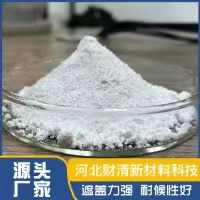
10 月 . 05, 2024 15:21 Back to list
Exploring the Properties and Applications of Mixed Crystal Nano Titania for Advanced Materials
Mixed Crystal Nano Titania A Revolutionary Material for Photocatalysis
Mixed crystal nano titania, often referred to as mixed-phase titanium dioxide (TiO2), has gained significant attention in recent years due to its exceptional photocatalytic properties. This material, combining both anatase and rutile phases of TiO2 at the nanoscale, offers a remarkable approach to tackling environmental and energy challenges. Its unique structural characteristics result in enhanced efficiency in various applications, particularly in the fields of environmental remediation, solar energy conversion, and self-cleaning surfaces.
The photocatalytic activity of mixed crystal nano titania is primarily attributed to its ability to harness sunlight. Titanium dioxide is a well-known photocatalyst, but its performance can be limited by its wide bandgap, which restricts the absorption of visible light. However, the incorporation of both anatase and rutile phases in mixed crystal structures allows for improved charge carrier dynamics, which can enhance photocatalytic activity even under visible light conditions. This makes mixed crystal nano titania a desirable material for sustainable energy solutions and environmental applications.
In waste water treatment, mixed crystal nano titania has shown to effectively degrade a range of organic pollutants, including dyes and pharmaceutical residues
. The material facilitates the production of reactive oxygen species (ROS) when exposed to light, which can oxidize contaminants, converting them into less harmful substances. This property is increasingly being utilized in advanced oxidation processes (AOPs), offering a promising solution to improving water quality and tackling pollution challenges.mixed crystal nano titania

Moreover, mixed crystal nano titania holds potential in the realm of solar energy conversion. By enhancing the efficiency of photocatalytic water splitting, the material paves the way for hydrogen production from sunlight, a clean and renewable energy source. The ability to produce hydrogen through efficient photocatalysis not only addresses energy needs but also contributes to reducing greenhouse gas emissions, making it a cornerstone in the fight against climate change.
In addition to environmental applications, mixed crystal nano titania is also being explored for its self-cleaning properties in various surfaces. When coated onto materials, it can decompose organic dirt and contaminants upon exposure to UV light, allowing surfaces to remain clean without chemical cleaners. This unique attribute is highly sought after in diverse industries, from architecture to automotive applications.
In conclusion, mixed crystal nano titania is revolutionizing fields ranging from photocatalysis to renewable energy production and self-cleaning technologies. Its enhanced photocatalytic properties and versatility make it a material of great promise in addressing some of the pressing global challenges related to energy and the environment. Ongoing research and development in this area continue to unveil new possibilities for its application, making it a focal point for future innovations.
-
Lithopone for Plastic & TiO2 R-5568/SK-6658 Masterbatch Solutions
NewsMay.30,2025
-
China Leading Rutile TiO2 Manufacturer - R5566 & R996 Grades Available
NewsMay.30,2025
-
High-Purity Anatase & Rutile TiO2 Powder Trusted Manufacturer
NewsMay.30,2025
-
High-Purity Anatase Products Trusted Supplier & Manufacturer
NewsMay.29,2025
-
Best Price Eco-Friendly Rutile TiO2 Supplier & Wholesale Factory
NewsMay.29,2025
-
Chinese Anatase Titanium Dioxide for Ceramic Glaze Reliable Supplier
NewsMay.29,2025
